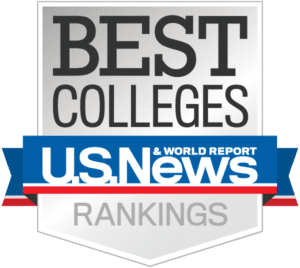
Innovation at Unity
A mission-driven, yet flexible mindset
that rewards and supports intentional risk-taking
What is Innovation at Unity Environmental University?
Innovation at Unity Environmental University is a mission-driven, yet flexible mindset that rewards and supports intentional risk-taking.
We create powerful new learning experiences and change higher education in order to address the evolving needs of society and the sustainability of the environment.
Guiding Principles for Influencing Innovative Behavior
- We support innovation by financial backing and human resources.
- We celebrate and respect those pursuing innovation.
- We celebrate the endeavor whether it is success or failure. You are not alone, we at Unity value innovation.
- All members of Unity Environmental University are contributors and supporters of innovation, and we embrace innovation in the face of perceived or real consequences.
- We regularly examine and evaluate innovation at Unity Environmental University.
Specific Structures and Policies that Challenge Innovation
- Diversity – Must be better incorporated into planning, hiring practices, and curriculum.
- Change – Resistance to new structures, departments, and policies, along with territorialism, can lead to discounting new ideas.
- Evaluation – Better alignment of evaluation practices and policies to job description, institutional goals, and innovation metrics.
- Time – More guidance and specific metrics are needed to quantify expectations and reallocate human resources in service to the future of the University.
- Resources – Dedicated financial resources to support new ideas.
On Innovation at Unity Environmental University
A statement for planning and discussion

Unity College Named #3 Most Innovative Schools. Unity College was named No. 3 (tie) for innovation by the 56 peer colleges in U.S. News and World Report’s north regional school category.
The Caterpillar and the Butterfly
By now, everyone at Unity Environmental University is very familiar with the “Life-Cycle of Higher Education” analogy as told by President Khoury: the higher education industry is like a cartoon caterpillar that enters its cocoon to begin an almost miraculous transformation into a very different being. During the months and even years in the cocoon, the caterpillar of higher education studies, reviews, researches, plans, and imagines its future. It studies every industry best practice, conducts listening tours, and audits itself until it understands itself as well as any institution can. After investment of a staggering amount of time and truly significant resources, the higher education caterpillar finally emerges from its transformative retreat, looks in the mirror, and smiles appreciatively at the very slightly more colorful and mildly more interesting, but largely unchanged, caterpillar smiling back at itself in the mirror.
In 2014, the Unity College (now Unity Environmental University) Board of Trustees adopted “Building a Beacon,” the ambitious strategic plan that called for an infrastructural framework that would provide Unity with a platform from which to leap forward. As it transitioned from Building a Beacon to the next strategic plan, Unity Environmental University found itself with the financial, human, facilities, IT, and policy infrastructure it needed to realize the next evolution of the University.
As it begins to emerge from its cocoon and looks to the future, the Unity Environmental University butterfly may not be fully mature, but it is increasingly clear to those who know higher education best, that Unity Environmental University is clearly no longer a traditional higher education caterpillar.
In summer of 2017, the Association of Governing Boards requested permission to develop and publish a case study on Unity College for their “Innovation in Higher Education” initiative. The initiative was published in Fall of 2017. The following is an excerpt from that case study where President Khoury explains why we have been slow to use the term “innovation” to describe our work.
AGB: What did this process teach you about developing a culture of innovation?
MPK: Not very long ago, Unity College had a college innovations committee. It was short-lived, but we discovered quickly that we had no lack of good ideas. It was prioritization, systems, and elbow grease we lacked. Through all the recent development, we haven’t talked much until recently about “innovation” per se. Instead, without really saying the word “innovation,” it has been bred into every committee, every work unit, every new undertaking. We’ve accomplished this by creating a culture of positive change: embedding return on investment, student success, and industry redesign into hiring expectations, job descriptions, budgeting processes, employee handbooks, and the like.
Honestly, rather than talking “innovation,” we’ve focused more on the step-by-step grind of reaching a particular goal, whether to establish a new campus farm, retail, and research station or changing the bylaws. Higher education is full of innovative thinkers and amazing ideas. The hard part seems to be making decisions, disciplining yourselves to focus on the priorities, then communicating and documenting the step-by-step process.
Part of the reluctance to focus on the term “innovation” is because words like that one can be overused to the point of being vacuous. Plus, as Dr. Khoury says “Cool kids don’t go around telling other people they are cool.”
A little later in the case study, when asked about lessons learned, Dr. Khoury talked about how important it is to turn innovation into a cultural norm; constantly strive to do better; and meet the pace of change.
AGB: What other lessons did you learn, and what advice would you offer other institutions pursuing innovation?
MPK: As an institution, we learned—we are still learning—that change is hard. Everyone says that, but until you live it as an institution the words don’t mean much. Change and innovation need to become the accepted and welcomed backdrop against which higher education operates. At Unity College, we have just begun to accept and internalize this reality.
We have not “arrived” and would not presume to give advice, but one habit we have found helpful is this:
Every time we are tempted to solve a problem with higher education industry “best practice,” we challenge ourselves to do better than “best practice” in an industry that is so important, but is struggling to adapt to the rate of change.Unity College is an environmental science school. We talk and think a lot about climate change. The real challenge of climate change is that the rate of global change will not slow to match our rate of adaptation. Higher education is like that. Change will outpace us if we don’t relentlessly work to keep up. As much as I recognize the value in taking things more slowly—as much as I would love to give our campus a break from change—as a college and an industry we simply cannot afford it. As a faculty member aptly said after one of my recent campus presentations, “Get busy living or get busy dying.” Or, as I like to say, “No margin, no mission.”
As AGB, the higher education leader in board of trustees development, began identifying Unity College as an innovator in higher education, Dr. Khoury turned to the college community to develop a Unity College specific take on the concept.
What Does “Innovation” Mean for Unity Environmental University?
On July 18 and 19, 2017, Unity College (now Unity Environmental University) hosted its annual leadership retreat. Along with other strategic discussions and work sessions, the team was asked to consider the question, “What does innovation mean for Unity College?” Retreat participants considered the question in a plenary session, then broke out into small groups to consider the nuances of innovation and its implications for the college. After the groups returned and reported, the results were compiled into several components: a definition of innovation, guiding principles to encourage innovation, and obstacles to be overcome in order to promote a culture of innovation at Unity.
The conversation focused largely on whether innovation at Unity should be thought of as type of action; as a result; or as something else entirely. In the end, the leadership team settled on an unlikely answer: innovation at Unity should be considered an approach or way of thinking about opportunity and challenge. A mindset.
After the group was back on campus and had some time to reflect, the work was further processed, and minor adjustments were made. The results were then presented to the college community for consideration and feedback during a “Unity Works” presentation and conversation. And more adjustments were made based on that feedback.
“Innovation at Unity College,” the resulting statement, represents the Unity perspective on innovation and serves as both a foundation for planning and as the starting point for future conversation.
Last Updated on September 28, 2023



